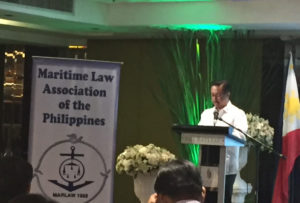

The Philippine Ports Authority (PPA) is awaiting approval of the National Economic and Development Authority (NEDA) Board to formally cancel the previous administration’s modernization project for Davao-Sasa port in order to proceed with its own new initiative.
PPA general manager Atty. Jay Daniel Santiago, in an interview with PortCalls on the sidelines of the “Sea Change” maritime conference jointly organized by the Maritime Law Association of the Philippines and PortCalls on February 24, said the modernization project needs to be cancelled first to “continue the development of Sasa to PPA’s own initiative.”
Once the modernization project is officially closed by the NEDA Board, PPA can then engage a new consultant to review and revalidate a 2012 PPA-commissioned feasibility study to modernize the Mindanao port. Santiago earlier said the PPA Board has agreed to shelve the previous administration’s big-ticket Davao-Sasa port modernization, opting instead to revisit a 2012 study commissioned by the port authority that recommends a lower project cost of around P5 billion.
In a presentation at the 9th Philippine Ports and Shipping Conference on February 23, PPA manager of commercial services Emma Suzara explained that the new PPA Board believes the Davao-Sasa port modernization project “may not work out because of several problems.”
In 2015, the Department of Transportation and Communications (DOTC), the precursor to the current Department of Transportation, started the bidding for the P19.7-billion Davao-Sasa Port modernization project under a public-private partnership (PPP) scheme. The project was based on a 2014 feasibility study DOTC commissioned.
Suzara said that aside from different project costs, there were other conflicting recommendations in the 2012 and 2014 feasibility studies.
She said recommendations differ in the size of the backup area and scope of reclamation, and in the project’s implementing agency, which in turn affects the composition of the pre-qualification, bids and awards committee.
The 2012 study said the concession fee should go to PPA while the 2014 study said this should go to either DOTC or the Department of Finance.
The 2014 study also called for an immediate 80% increase in tariff, which Suzara said was alarming for PPA.
There were also differences concerning the collection of port charges and viability of funding.
While the PPA Board has ordered the revocation of the previous administration’s port modernization project, Suzara said the board agreed to not completely drop the idea. Thus, it directed PPA to get a consultant to review, validate, and update the 2012 study on the Davao port modernization.
Aside from revalidation, the new consultant will have to take into consideration the other players in the area. Suzara said “we have to consider that there are private ports that are operating efficiently… and their private ports are world class.”
“We feel that they should be allowed to operate as well,” Suzara pointed out, emphasizing that the new competition law forbids barriers to the entry of players.
Asked about the possibility of a higher project cost emerging from the proposed revalidation of the 2012 study, PPA chief Santiago said it was “reasonable” in light of inflation and foreign exchange rates.
He added that equipment acquisition will also affect the cost since “we will install new crane systems there, so we will have to look at new equipment that will complement the system, which have probably not been available back in 2012.”
Santiago said while there would definitely be an upward adjustment to the project cost, it would still be lower than earlier proposed P19.7 billion. – Roumina Pablo




